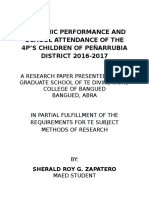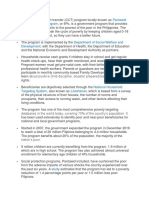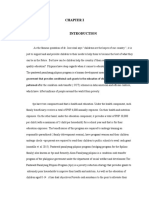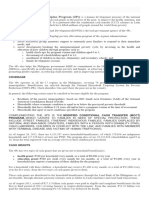Al - RRL
Al - RRL
Uploaded by
jendale14Copyright:
Available Formats
Al - RRL
Al - RRL
Uploaded by
jendale14Original Description:
Copyright
Available Formats
Share this document
Did you find this document useful?
Is this content inappropriate?
Copyright:
Available Formats
Al - RRL
Al - RRL
Uploaded by
jendale14Copyright:
Available Formats
Many approaches have taken with an end view of significant development in the countrys
exploit against nationwide poverty and hunger as the country came through the last few decades.
The governments later resolution for transparency may have contributed to this but it was mainly
the noteworthy economic expansion along with growth of the different local industries that played
a major role behind the mobility of the citizens, particularly the poor, at least as supported by many
studies. (Dollar and Kray 2004, Rodrik 2000)
Through the efforts of numerous public agencies, programs for asset reforms and provision
of employment and human development were initiated. Among these were the Comprehensive
Agrarian Reform Program (CARP) and the Indigenous Peoples Rights Act which were established to
redistribute physical or financial assets to the poorest individuals and to provide access to land and
capital and eventually hand a long-term ownership of these productive areas over to marginalized
groups. While public avenues for job creation were also opened through the welcoming of new
industries in the country, access to basic needs of health and nutrition, shelter, water and sanitation
also improved through the flagship program of the Arroyo Administration titled Kapit-Bisig Laban
sa Kahirapan Comprehensive and Integrated Delivery of Social Services Project or KALAHI-CIDSS.
(Aldaba, et al, ADB 2009) Moreover, other projects were also implemented to provide social
protection for vulnerable groups outside of the other programs and enhance their abilities and
capacity to participate in the government policy and decision making. Consequently, a degree of
social change was realized and at the same time, the range of families rated below the poverty line
declined from 40-44% down to 24-27% of the population surveyed by the Asian Development Bank
from the Marcos to Arroyo administration. (Social Weather Stations, December 2008)
Despite these results, with the exponential growth of the nations population along with the
rapid rise in prices of food, fuel, and other primary commodities, the efforts needed to maintain or
uplift the countrys current status concerning poverty remain a challenge. To be specific, the latest
poverty and inequality statistics released by the National Statistical Coordination Board in April
2013 showed that the total income earned by the top 20% earners of the 51,000 target households
tested was eight (8) times the total income of the bottom 20% families in the first half of years
2006, 2009 and 2012 - the periods within which the three-year gap, Family Income and
Expenditure Survey (FIES) were conducted. The said poorest segment of the population (the
bottom 20%) accounts for only six percent (6%) of the total national income, while the upper
twenty percent (20%) contributes up to approximately 50% of the national income (The Philippine
Star, April 2013). Within the three-year period, around 10% of these households live with per
capita annual incomes less than their per capita consumption or the minimum cost of food items
that can satisfy nutritional requirements for economically necessary and socially desirable physical
activities. Ultimately, one could validly say that that 28 out of 100 Filipinos specifically during those
periods lived in poverty - at least 10 of which barely earn enough income to neither afford a healthy
meal on their tables nor provide their children the proper education they need.
By year 2012, an average Filipino family of five needed Php 5,458 monthly income to buy
their basic physical needs and Php 7,821 monthly to afford other non-food needs. Overall, the status
of poverty in the Philippines practically hasnt changed from the first half of 2006 to the first
semester of 2012. (Asian Development Bank Institute, 2013)
Pantawid Pamilyang Pilipino Program (4Ps)
In light of this public concern, and in view of the success of the same initiative in other
countries, Senator Miriam Defensor Santiago proposed a Conditional Cash Transfer (CCT) program
to address the escalating problem of poverty in the Philippines. This program is now known as
Pantawid Pamilyang Pilipino Program (4Ps).
The Pantawid Pamilyang Pilipino Program is a human development program of the national
government primarily aimed at the reduction of poverty and its intergenerational cycle in the
country. It invests in the health and education of poor households, particularly of children aged 0-
14 years old and provides cash grants to beneficiaries provided that they comply with the
conditions attached to the program. Essentially, the program aspires to achieve two main
objectives: Social Assistance to provide cash assistance to the poor to alleviate their immediate
need (short-term poverty goals) and; Social Development to break the intergenerational poverty
cycle through investments in human capital (long-term poverty goals).
(http://pantawid.dswd.gov.ph)
While 4Ps targets only a few domains of poverty like education and health care, it is, for all
intents, a part of the chain of actions undertaken by the government to fulfill its commitment to
meet the Millennium Development Goals which includes the eradication of extreme poverty,
achievement of universal primary education, promotion of gender equality, reduction of child
mortality, and improvement of maternal health (DSWD, About 4Ps, pantawid.dswd.gov.ph).
Through the program, a budget of P10 million a year has been allotted for 70,000 family
beneficiaries and as of June 26, 2013, 4Ps operates in 79 provinces covering 1484 municipalities
and 143 key cities (including Iligan City) in all 17 regions nationwide with 3,927,917 registered
households.
The following information lays the essential details about the program as described in the
DSWD website, pantawid.dswd.gov.ph.
Targeting System
Households classified as poor, based on the National Household Targeting System for
Poverty Reduction (NHTS-PR) implemented by the DSWD, are selected using the Proxy Means Test
(PMT) at the time of assessment. The PMT determines the socio-economic category of the families
by looking at certain proxy variables such as ownership of assets, type of housing, education of the
household head, livelihood of the family and access to water and sanitation facilities.
As of July 1, 2011, the NHTS-PR has identified 5,225,118 poor households out of 10,909,456
households enumerated which, as previously mentioned, were identified based on the PMT result.
Among those selected, households that have children 0-14 years old and/or have a pregnant
woman at the time of assessment are considered eligible.
Selected households should also agree to meet conditions specified in the program. For
education, for instance, children 3-5 years old must attend daycare/preschool program at least
85% of the time. Children 6-14 years old must also enroll in elementary or high school and attend at
least 85% of the time. In terms of health, children 0-5 years old must get regular preventive health
check-ups and vaccines. Pregnant women must avail pre- and post-natal care and be attended
during childbirth by a trained health professional and children 6-14 years old must received de-
worming pills twice a year. Moreover, parents/guardians are also required to attend responsible
parenting sessions, mothers classes on health and nutrition, parent effectiveness services and
other topics fit for their needs and interest at least once a month.
Program Package
The program allows every selected household to receive a health grant of P500 per month
or a total of P6, 000 per year and an education grant of P300 per month for ten months or a total of
P3,000 in a year for children 3-14 years old with a maximum of three children per household.
In aggregate, each household beneficiary may receive a maximum cash grant of P1, 400 per
month (P500/month for health and P900/month for education) for five years as long as the
conditions are complied.
Distribution of Payments
The Land Bank of the Philippines is the authorized bank to manage the disbursement of
cash grants to the beneficiaries. Having limited branches to cater all the beneficiaries nationwide,
Land Bank has engaged the services of other financial institutions and telecommunication
companies to help them disburse the grants to the beneficiaries. To date, the beneficiaries may
receive their grants through Land Bank itself (cash cards, over-the-counter, off-site), G-cash remit
and other rural banks. Beneficiaries with cash cards may also withdraw their grants in Cooperative
Financial Institutions, First Consolidated Bank and M. Lhuillier.
The payment is given to the most responsible adult in the household, which is usually the
mother.
Compliance Verification System
Compliance Verification System (CVS) is the system set-up by 4Ps to monitor the workers
fill-up the CVS forms. The CVS also serve as the basis in computing the grant of each household.
Pilot Implementation
The program was first put into practice during the last quarter of 2007 covering about 4589
households in four (4) municipalities and two (2) cities in CARAGA, Region IX and NCR. The
preliminary report in January 2009 conducted by the International Institute of Rural
Reconstruction (also known as, IIRR), as commissioned by World Bank, Manila Phil and Australian
Aid, revealed the early indicators of the outcome of the program from the benefited communities.
The assigned responsible persons in the local government accepted and understood their roles to
offer a strong support and commitment to the implementation of 4Ps, ensuring that proper services
and assistance are given to the selected families with the help of the active involvement of health
workers, midwives, and school teachers and supervisors at the local community level. The
beneficiaries also shared an optimistic view with the conditions they had to meet to stay in the
program. For instance, children enrolled in primary schools marked up to 95% attendance during
that school year. There was also a remarkable increase in attendance of pregnant women and
children aging 0-5 years old in the scheduled medical checkups and health visits. In addition, the
community meetings and seminar made a great place for the parents to learn more about
responsible parenting and provided them the opportunity to raise their concerns, grievances, and
other important matters relating to the project and its implementation in the barangay where they
are situated. Interestingly, the report also revealed how the women who were designated with the
responsibility of the cash assistance granted, especially the parent leaders of their respective
clusters, felt empowered by the program. (International Institute of Rural Reconstruction, 2009)
You might also like
- Millions Saved: New Cases of Proven Success in Global HealthFrom EverandMillions Saved: New Cases of Proven Success in Global HealthRating: 5 out of 5 stars5/5 (1)
- Chapter 2 - Related LitDocument17 pagesChapter 2 - Related LitRheann Marie Bugtong67% (12)
- Urban Land Use TheoriesDocument18 pagesUrban Land Use TheoriessanamNo ratings yet
- Academic Performance and School Attendance of The 4pDocument18 pagesAcademic Performance and School Attendance of The 4pRaveline Labrador92% (111)
- Pantawid Pamilyang Pilipino ProgramDocument15 pagesPantawid Pamilyang Pilipino ProgramMark CasemNo ratings yet
- 4ourPeaceofMind 3Document34 pages4ourPeaceofMind 3Kyle Rurence A. BartolomeNo ratings yet
- The Effectiveness of Pantawid Pamilyang Pilipino Program Into Nation BuildingDocument5 pagesThe Effectiveness of Pantawid Pamilyang Pilipino Program Into Nation BuildingservandonicoleNo ratings yet
- The Conditional Cash TransferDocument11 pagesThe Conditional Cash TransferChristian Surio RamosNo ratings yet
- 4 Ps SssssssDocument35 pages4 Ps SssssssHappyNeversmilesNo ratings yet
- Review Related LiteratureDocument5 pagesReview Related LiteratureMax zeo VilloteNo ratings yet
- Review of Related Literature and StudiesDocument10 pagesReview of Related Literature and StudiesRamil Depalma Nebril100% (1)
- 4 PsDocument28 pages4 PsVincentNo ratings yet
- Position Paper On The 4psDocument7 pagesPosition Paper On The 4psDavid Dueñas100% (5)
- Poverty 2Document9 pagesPoverty 2Camid AlanissahNo ratings yet
- Chapter 2 4psDocument11 pagesChapter 2 4psfatima b. coronel100% (1)
- 4Ps Thesis Academic PerformanceDocument16 pages4Ps Thesis Academic PerformancePr. Quirino Lucya100% (1)
- Pantwaid Pamilya Pilipino Program ResearchDocument6 pagesPantwaid Pamilya Pilipino Program ResearchKris Anthony SyNo ratings yet
- The Pantawid Pamilyang Pilipino ProgramDocument3 pagesThe Pantawid Pamilyang Pilipino Programlanie_jecielNo ratings yet
- 4 Our Peaceof MindDocument33 pages4 Our Peaceof MindKyle Rurence A. BartolomeNo ratings yet
- DSWDDocument11 pagesDSWDJane GalvanNo ratings yet
- CHAPTER 1 and 2Document20 pagesCHAPTER 1 and 2Mariel Ellaine Into100% (2)
- 4PS BeneficiariesDocument22 pages4PS Beneficiariesbaoshi3382No ratings yet
- Conditional Cash Transfer Program in The Philippines: Is It Reaching The Extremely Poor?Document16 pagesConditional Cash Transfer Program in The Philippines: Is It Reaching The Extremely Poor?Thgiwd EnyawdNo ratings yet
- Practical Research 2Document13 pagesPractical Research 2Rusty TorresNo ratings yet
- Swot Analysis On Ra 11310: Submitted byDocument4 pagesSwot Analysis On Ra 11310: Submitted bywilliam bill doria100% (1)
- Case StudyDocument4 pagesCase StudyDolly UcagNo ratings yet
- Thesis Chapter 1Document11 pagesThesis Chapter 1Mark Aldrin86% (7)
- 4ps OverviewDocument12 pages4ps Overviewjmvincent100% (1)
- 4pspantawid Pamilyang Pilipino ProgramDocument10 pages4pspantawid Pamilyang Pilipino Program2022maedllamedoannNo ratings yet
- 4 PsDocument28 pages4 PsVincentNo ratings yet
- Pantawid Pamilyang Pilipino Program - Official Gazette of The Republic of The PhilippinesDocument5 pagesPantawid Pamilyang Pilipino Program - Official Gazette of The Republic of The PhilippinesAli HasanieNo ratings yet
- The Conditional Cash Transfer Program inDocument37 pagesThe Conditional Cash Transfer Program inbergadorolan61No ratings yet
- PantawidManual PDFDocument391 pagesPantawidManual PDFGab MusaNo ratings yet
- Gov. ProgramsDocument1 pageGov. ProgramshannahNo ratings yet
- UNKNOWNDocument13 pagesUNKNOWNnhayrahdicunugunNo ratings yet
- Chapter 1Document5 pagesChapter 1Benz GarciaNo ratings yet
- 4 PsDocument2 pages4 Pscherrymae.maglasangNo ratings yet
- CeliaReyes PaperDocument42 pagesCeliaReyes PaperNerissa PascuaNo ratings yet
- Feb20.2015.docinstitutionalize A National Conditional Fund Transfer Program - SolonDocument2 pagesFeb20.2015.docinstitutionalize A National Conditional Fund Transfer Program - Solonpribhor2No ratings yet
- 4ps ThesisDocument10 pages4ps ThesisptalimioNo ratings yet
- An Initial Assessment of The Pantawidd Pamilyang Pilipino Program - Looking at Possible Potentials and PitfallsDocument8 pagesAn Initial Assessment of The Pantawidd Pamilyang Pilipino Program - Looking at Possible Potentials and Pitfallsshobekai30100% (1)
- Effectiveness of Social Assistance Expansion: Pantawid Pamilyang Pilipino Program (4Ps) As A Social Development Strategy in Quezon CityDocument13 pagesEffectiveness of Social Assistance Expansion: Pantawid Pamilyang Pilipino Program (4Ps) As A Social Development Strategy in Quezon CityRinaNo ratings yet
- 274-Article Text-815-3-10-20210819Document8 pages274-Article Text-815-3-10-20210819202110021No ratings yet
- StephDocument2 pagesStephJeffrey SamontesaNo ratings yet
- Review Related Literature: CommentedDocument3 pagesReview Related Literature: CommentedShri Joie AdelmitaNo ratings yet
- 4PSDocument9 pages4PSVaishaNo ratings yet
- ShengDocument47 pagesShengJanice LopecilloNo ratings yet
- Pantawid Pamilyang Pilipino Program (4Ps)Document8 pagesPantawid Pamilyang Pilipino Program (4Ps)Janna Lorence Soriano-PenillaNo ratings yet
- Review of Related Literature and StudiesDocument24 pagesReview of Related Literature and StudiesJannica Tan Chin Ü100% (1)
- Title Proposal 2Document24 pagesTitle Proposal 2Maricel RaguindinNo ratings yet
- NSTP 2 Module 4 - Poverty-1Document42 pagesNSTP 2 Module 4 - Poverty-1kristenejeff.caraleNo ratings yet
- Pantawid OM, ANNEx, SWDRP and IPPF PDFDocument382 pagesPantawid OM, ANNEx, SWDRP and IPPF PDFMennaldzAkinAmilhasan100% (1)
- Pantawid Pamilyang Pilipino Program - WikipediaDocument9 pagesPantawid Pamilyang Pilipino Program - WikipediaCastillo RaymartNo ratings yet
- Maryjoy Mella, Floren Camille Osido and Lemarie SuingDocument6 pagesMaryjoy Mella, Floren Camille Osido and Lemarie SuingfnjkbvbdvNo ratings yet
- Pantawid Pamilyang Pilipino Program The ProgramDocument3 pagesPantawid Pamilyang Pilipino Program The ProgramJan Briane Fabie AstomNo ratings yet
- IE Wave 1 Executive Summary 1Document4 pagesIE Wave 1 Executive Summary 1John Reyes PagcaliwanganNo ratings yet
- Thesis CCT ProgramsDocument25 pagesThesis CCT ProgramsNerissa Pascua100% (1)
- The Problem and Its BackgroundDocument40 pagesThe Problem and Its BackgroundJuan MakasalananNo ratings yet
- Chapter 1Document5 pagesChapter 1Nikka Espinosa LanatNo ratings yet
- Implementation of Pantawid Pamilyang Pilipino ProgDocument8 pagesImplementation of Pantawid Pamilyang Pilipino Progits.airish06No ratings yet
- Zed Research 2016Document3 pagesZed Research 2016ZelelewNo ratings yet
- Irish Business CultureDocument14 pagesIrish Business CultureAndra LazarNo ratings yet
- Blifa: Better Life Initiative For The AgedDocument13 pagesBlifa: Better Life Initiative For The AgedMonday EdetNo ratings yet
- AGRICULTUREDocument8 pagesAGRICULTUREANKIT RAJNo ratings yet
- LUGAIT Situational Analysis My EditsDocument20 pagesLUGAIT Situational Analysis My EditsPrincess Lotsen AromaNo ratings yet
- Dr. Rebecca Saunders, Dr. Rebecca Saunders, Christopher T. Hays, Christopher T. Hays, Richard A. Weinstein, Anthony L. Ortmann, Kenneth E. Sassaman, James B. Stoltman, Tristram R. Kidder, Jon L. Gibson, Prentice Thom.pdfDocument294 pagesDr. Rebecca Saunders, Dr. Rebecca Saunders, Christopher T. Hays, Christopher T. Hays, Richard A. Weinstein, Anthony L. Ortmann, Kenneth E. Sassaman, James B. Stoltman, Tristram R. Kidder, Jon L. Gibson, Prentice Thom.pdfhotdog10100% (1)
- The Rattrap SummaryDocument8 pagesThe Rattrap Summarykeerthy100% (1)
- Theories of Poverty: A Critical ReviewDocument8 pagesTheories of Poverty: A Critical ReviewMatsaung Jacob Thabo HolloNo ratings yet
- What Is UNDP? / IntroductionDocument3 pagesWhat Is UNDP? / Introductionprati pNo ratings yet
- LIFT Impact Report 2012Document32 pagesLIFT Impact Report 2012LIFTcommunitiesNo ratings yet
- Global StratificationDocument3 pagesGlobal StratificationFeera SabbaNo ratings yet
- The Overall Winning Essay On 'The Future African City'Document6 pagesThe Overall Winning Essay On 'The Future African City'Oluwole DaramolaNo ratings yet
- UNICEF Philippines ECCD and BE Report OPM Final 30mar2017Document128 pagesUNICEF Philippines ECCD and BE Report OPM Final 30mar2017berrygNo ratings yet
- Poverty and Economic Inequality: Basic MicroeconomicsDocument50 pagesPoverty and Economic Inequality: Basic MicroeconomicsRezel FuntilarNo ratings yet
- Higher Secondary Examination 2012 General English Class-XIIDocument15 pagesHigher Secondary Examination 2012 General English Class-XIIAr Raj YamgarNo ratings yet
- FACTS On AGING QUIZ With Tentative AnswersDocument5 pagesFACTS On AGING QUIZ With Tentative Answersjuno_j1No ratings yet
- Lost Spring: Short Answer Type Questions (2 Marks, 30-40 Words)Document2 pagesLost Spring: Short Answer Type Questions (2 Marks, 30-40 Words)shahin appuNo ratings yet
- Specialization Choice: Social Protection Policy Design & FinancingDocument34 pagesSpecialization Choice: Social Protection Policy Design & FinancingMGSoGNo ratings yet
- AP DraftDocument3 pagesAP DraftVictoriaNo ratings yet
- A Strategy To End PovertyDocument9 pagesA Strategy To End Povertyscottnewton11No ratings yet
- Mapeh PoemDocument3 pagesMapeh PoemJohn Raymund TamargoNo ratings yet
- Issues and Concerns of School Dropouts in IndiaDocument6 pagesIssues and Concerns of School Dropouts in IndiaarcherselevatorsNo ratings yet
- Regulating Wastage Along Food Supply Chain - Case Study of Indore by The Shishukunj International School PDFDocument51 pagesRegulating Wastage Along Food Supply Chain - Case Study of Indore by The Shishukunj International School PDFSaumyasNo ratings yet
- What Is DemocracyDocument24 pagesWhat Is DemocracyVyshakNo ratings yet
- Barangay Development Plan 2018-2020: Maananteng, Solsona, Ilocos NorteDocument40 pagesBarangay Development Plan 2018-2020: Maananteng, Solsona, Ilocos Nortealecx segoviaNo ratings yet
- Informative SpeechDocument2 pagesInformative SpeechkeaneNo ratings yet
- Rough Draft.Document2 pagesRough Draft.CelineNo ratings yet
- SBI Clerks' Grade: Recruitment ExamDocument29 pagesSBI Clerks' Grade: Recruitment ExamtonydisojaNo ratings yet
- M.B Khan TradeDocument16 pagesM.B Khan TradeM B KhanNo ratings yet

























































































